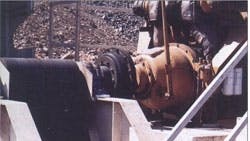Selecting elastomeric couplings to halt troublesome vibration
Excessive vibration is at the root of many problems with rotating drive systems. But, you as a designer can use elastomeric couplings to reduce the transmission of torsional vibration so the drives run smoother and last longer.
Before selecting an elastomeric coupling to minimize vibration effects, as well as accommodate misalignment, you need to know these system parameters:
• Operating speed.
• Rotational inertia of driven load.
• Transmitted power.
• Shaft misalignment.
• Operating environment.
The following example shows how to use this information for selecting the right coupling.
Example
A 100-hp, 8-cylinder, 4-stroke engine that operates at 1,200 rpm is connected to a gearbox through an elastomeric coupling. To protect the gearbox and maximize its service life, the manufacturer wants the coupling to isolate 97% of the engine’s torsional vibration. The rotational inertia of the driven load is 20 lbin.- sec2/rad.
The key to isolating the engine’s vibration (reducing the amount of vibration transmitted through the drive system), is to design the system so its natural frequency is well below the disturbing frequency.
1. First, calculate the disturbing frequency generated by the engine. The disturbing frequency for a 4-stroke engine is obtained using the equation:
Fd = (N x S)/(2 360)
where:
Fd = Disturbing frequency, cycles/sec or Hz.
N = Number of engine cylinders.
S = Speed, rpm. Accordingly:
Fd= (8 x 1,200)/120 = 80 Hz
For other engines or motors, the disturbing frequency is obtained from:
Two-stroke engine: Fd = (N x S)/60
Electric motor: Fd = (N x S)/60
where:
N = Number of engine cylinders or electric motor stator poles.
2. Determine the required natural frequency of the system from the equation:
Fn = Fd/[1/(1-I) + 1]1/2
where:
Fn = Required natural frequency, Hz I= Required isolation (0.97). This gives:
Fn= 80/[1/(1-.97) + 1]1/2 = 14 Hz
If the required isolation is not specified or known, you can calculate the maximum allowable natural frequency from the simpler equation:
Fn = Fd/1.414
Keeping the natural frequency below this value will prevent amplification or buildup of the torsional vibration transmitted through the system.
3. Determine the inertia of the driven load. Many times this information is available from the equipment manufacturer. In this case, the manufacturer specified the driven load inertia as J = 20 lb-in.-sec2/rad.
You can also calculate inertia using standard formulas found in most engineering texts and the PTD Handbook, p A21. A common technique is to divide the driven mass into simple geometric sections (usually cylinders), calculate their individual inertias, and add these values to obtain the total inertia.
4. Determine the required torsional spring rate, or stiffness, of the coupling from the equation:
K= J x (2π x Fn)2
where:
K = Required torsional spring rate, lbin./ rad. J = Driven load inertia, lb-in.-sec2/rad.
Thus:
K = 20 3(2π x 14)2 = 154,598 lb-in./rad
This can be converted to lb-in./deg by:
K = 154,598/57.3 = 2,698 lb-in./deg
5. Determine the torque applied to the coupling by the engine, using:
T = (P x 63,025)/S
where:
T = Torque applied to coupling, lb-in. P = Power supplied by the engine, hp.
Thus:
T = (100 363,025)/1,200 = 5,252 lb-in.
6. Finally, select a coupling with the required torsional spring rate from the manufacturer’s catalog or selection chart, making sure that the coupling can handle the applied torque, speed, misalignment, and operating temperatures. Table 1 shows part of a typical selection chart, in this case, for rubber-tire-type couplings.
Referring to Table 1, first find the coupling with a torsional spring rate that is closest to, but does not exceed, the required rate calculated in step 4. Here, you would choose the model M8 coupling, which has a spring rate of 2,420 lbin./ deg.
Then verify that the coupling can transmit the engine torque calculated in step 5. The M8 coupling accommodates up to 7,750 lb-in. torque, which exceeds the required 5,252 lb-in.
Next, check whether the selected coupling can accommodate the required shaft misalignment. In this case, the coupling accommodates up to 4-deg angular and 1/8-in. parallel misalignment, which is adequate for many applications.
Finally, make sure the coupling can operate at the required speed. Here, the M8 coupling is rated for 2,300 rpm and therefore, can easily accommodate the 1,200 rpm operating speed.
David F. Reynolds is a senior development engineer and Brian Young is a customer order engineer at DODGE/Reliance Electric, Greenville, South Carolina.
